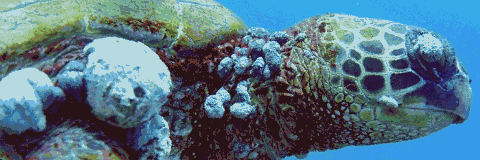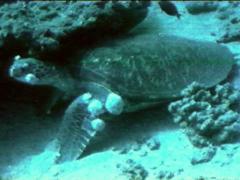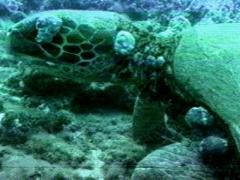 |
||
 |
||
Ed. note: This essay was originally posted on May 21, 1995. Although the format of this page has been modified since then, the content of the essay has remained untouched. Some of the material in this essay has become outdated with progress in the research concerning fibropapilloma, and also with our own continuing education about the disease. The essay remains here for context.
In humans, a papilloma tumor is a benign growth that is spread by a virus. One example is the ordinary wart. Other mammals also develop papilloma tumors, and scientists have noted many similarities and varieties.
When papilloma tumors develop predominant fibrous tissue, they are called fibropapillomas. Green sea turtles develop fibropapillomas that appear as lobe-shaped tumors. These tumors can infect all soft portions of a turtle's body. Tumors grow primarily on the skin, but they can also appear between scales and scutes, in the mouth, on the eyes, and on internal organs.
The lesions are small at first, but they can grow to 10 cm or more in diameter. In the turtles we have observed since 1989, the early stages of the disease have followed a predictable pattern. First, the turtle developed suspicious white spots on its body, most often around the neck and shoulders. We refer to this as "salt and pepper" because the appearance is not unlike what you would get if you took a salt shaker and salted a turtle.
Within a year, these white spots usually developed into full blown tumors. The disease frequently affects the eyes first, but we have seen tumored turtles with clean, healthy eyes, so this is by no means a rule.
The course of the tumors can vary greatly among individuals. We have seen turtles develop a mild case that changes little from year to year. We have even seen what appears to be regression of tumors--but this is not the norm.
Most of the turtles we have observed with the disease steadily worsen. Tumors increase in both number and size. Particularly gruesome are tumors that develop along the neck of turtles. Picture roughly two dozen tumors the appearance and texture of "horse apples" stuck to a turtle's neck, and you have an excellent idea of what a stricken turtle looks like.
For whatever reason, the disease runs rampant in the juvenile turtles we observe. From "salt and pepper" to emaciation can be as little as two years. (Noke is a graphic example.) In adults, the disease is less predictable. We have seen everything from one turtle (Tutu) who had a mild case and recovered completely to another (1991 Turtle 1) who was weak and emaciated within four years.
The sad truth of the matter is that scientists aren't yet certain what causes fibropapilloma tumors or how they are spread.
There is a lot of research being conducted to answer these questions, and while progress is being made, so far there are no definitive answers. Because papilloma tumors are spread by a virus in other animals, it is quite likely that a virus is the culprit in green turtles. Recent research has strongly indicated that a herpesvirus might be the culprit, but more work is needed to decide the issue. Unfortunately, money is hard to get, making it difficult to fund the kind of sustained project that would have the best chance of succeeding.
It is also not clear how the virus, if a virus is indeed the cause, infects the turtles. Infected turtles have remained in close contact with clean turtles in captivity for years without spreading the disease to them. This suggests a carrier that is present only in the wild, but attempts to find such a carrier have not yet been successful.
Another unexplained mystery is why the disease has reached epidemic proportions in Hawaii, Florida, and Barbados simultaneously. Since green turtles have been known to range quite far, it is possible that the outbreaks in Florida and Barbados are somehow related, but this cannot explain the problem in Hawaii.
There have also been attempts to discover whether pollutants could be a factor. So far, studies have been unable to find any unusual concentrations of pollutants in the afflicted populations.
It is possible that the disease is the result of a combination of factors. For example, turtles under stress from pollution could be more vulnerable to a virus that would otherwise be relatively harmless. Again, thus far research has not been able to find such a relationship.
While considerable effort has been expended in understanding the cause and spread of fibropapilloma, it is none the less quite frustrating that there is still so much we do not know.
 |
||
| 1991 Turtle 9 | ||
For us, however, it has become personal. We have dived with the same turtles for years and we have come to love them and regard them as friends. Each summer we return to see yet another friend develop "salt and pepper" and then the tumors. Even though the "salt and pepper" gives us a year to steel ourselves, seeing the actual tumors show up on a friend still makes us cry at the moment of sighting.
For the turtles, tumors, even small ones, mean they become the target of saddleback wrasses and whitespotted tobies at the cleaning station. These fish inflict painful bites directly on the fibropapilloma, apparently eating parasites that infest the tumors. Afflicted turtles are often forced to leave a cleaning site prematurely. Over time, their tumors worsen and their time at cleaning stations becomes shorter and shorter.
A thick coat of algae develops on their shells, and even on their skin. Tumors increase in number and size, resulting in more drag and making swimming more difficult.
Tumors often grow to cover both eyes. In 1994, we saw a turtle with an eye tumor so large that it obscured half its left profile. Tumors growing in the corners of the mouth make breathing and eating difficult. One turtle we saw had a tumor growing out of its anus. No soft part of a turtle is spared.
There comes a point in the disease when you think the turtle is really just a way for the tumors to get around. There is little turtle left, the way there is little grasshopper left once a spider is finished sucking it dry. Our friends, whom we have seen daily for years, develop tumors, worsen, and then one day are nowhere to be found. Animals that have had routines like clockwork are just--gone.
 |
||
| 1991 Turtle 13 | ||
The growing incidence of a debilitating and disfiguring disease known as fibropapilloma in the Hawaiian green turtle (or honu), Chelonia mydas, formed the subject of a recent review calling attention to this potentially serious phenomenon. Since that time the occurrence of the disease in the Hawaiian Islands has continued to increase in both geographic range and magnitude. This assessment is based on the capture, examination, and tagging of live turtles; records of strandings; and verifiable reports received from divers and other ocean users in Hawaii. The principal concern among the public and scientific sectors for this worsening situation centers on the well-being and survival outlook of the green turtle, a protected species under the U.S. Endangered Species Act and wildlife laws of the state of Hawaii. Other important concerns include the negative visual impacts related to marine tourism and underwater photography by Hawaii's substantial skin and scuba diving industry; the perception that toxic pollutants of some unknown nature and origin may be contaminating certain nearshore marine habitats, thereby causing the disease; and possible human health hazards related to exposure to live afflicted turtles and stranded carcasses.
In reponse to the above issues, the draft Hawaiian Sea Turtle Recovery Plan designated the fibropapilloma problem as a high priority research need. The green turtle population in Hawaii has shown a gradual increase in numbers since full legal protection was afforded in 1978. However, members of the population are known to exhibit slow rates of growth, with the average age of sexual maturity estimated at 25 years old. Consequently, the full impact to the population in terms of recruitment of adult nesting turtles, if the disease continues at the present pace, may not be manifested for decades.
The earliest confirmed case of green turtle fibropapilloma (GTFP) in Hawaii dates back to January 1958. The 1958 case GTFP case involved an immature turtle captured alive by fishermen in Kaneohe Bay on the Island of Oahu. Kaneohe Bay is the largest bay in the Hawaiian Islands, comprising substantial foraging and resting habitat for green turtles. Numerous other reports involving the capture, handling, and sighting of hundreds, if not thousands, of turtles by former turtle fishermen and other reliable informants indicate that GTFP was virtually nonexistent prior to and during the 1950's and early 1960's. Furthermore, no evidence has bene found that live green turtles were ever imported alive into Hawaii from Florida or elsewhere in the Caribbean, where GTFP was first described in the scientific literature in the 1930's as an occasional occurence.
From 31% to 53% of the stranded turtles examined each year since 1983 have had GTFP. During 1990, 154 green turtle stranding cases occurred throughout the 8 main (inhabited) Hawaiian Islands, the highest number since the stranding network was established in 1983. During 1989 and 1990, GTFP was present in 77% and 85% of the turtles stranded on the Island of Maui, mainly in the Kahalui Bay area.
In Kaneohe Bay the live capture by hand of 121 turtles at 4 discrete habitat sites since February 1989 has shown GTFP rates of 49-92%. Turtles with GTFP have been coded by their degree of tumor severity on a scale of 1-4 (stage 4 being the most severe). This evaluation is based on the size, number, and location of the tumors present. Some turtles with codes as high as 3 and 4 have shown substantial vigor, fleeing with force and trying to aggressively bite the persons restraining them. Other turtles with similar tumor severity are lethargic, emaciated, and easily captured for examination. Cardiovascular parasites are commonly found in these turtles when they strand ashore near death.
George H. Balazs
Honolulu Laboratory
Southwest Fisheries Science Center
National Marine Fisheries Service, NOAA
For the remainder of this article and other information concerning marine turtle fibropapillomas, contact the U.S. National Marine Fisheries Service.
|
|
Sickbay | ||||
|
|
Table of Contents | ||||